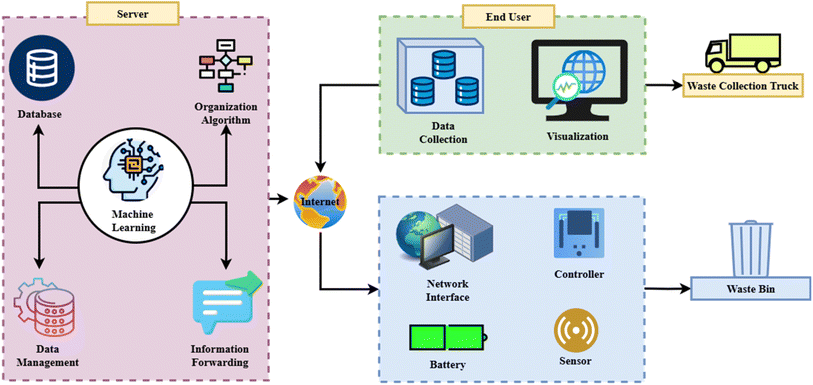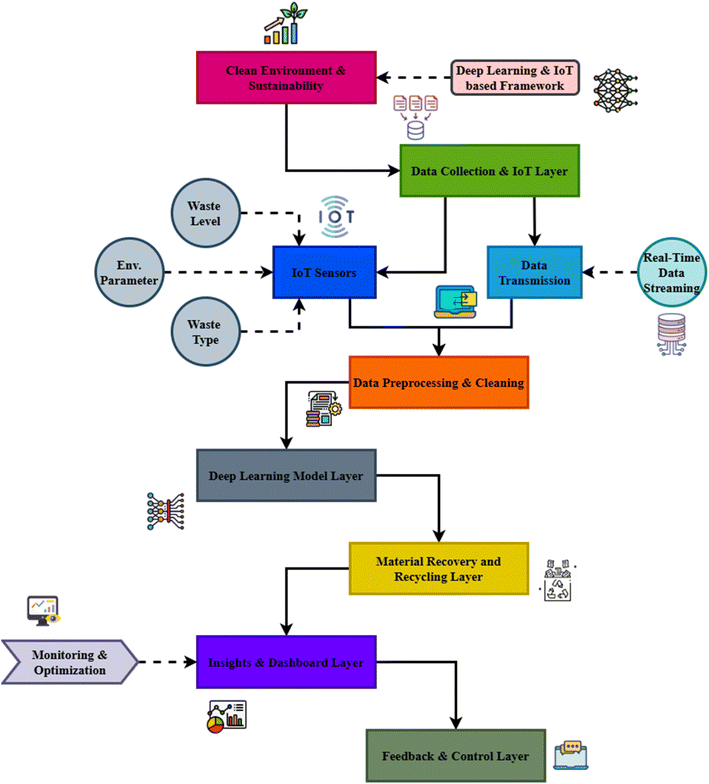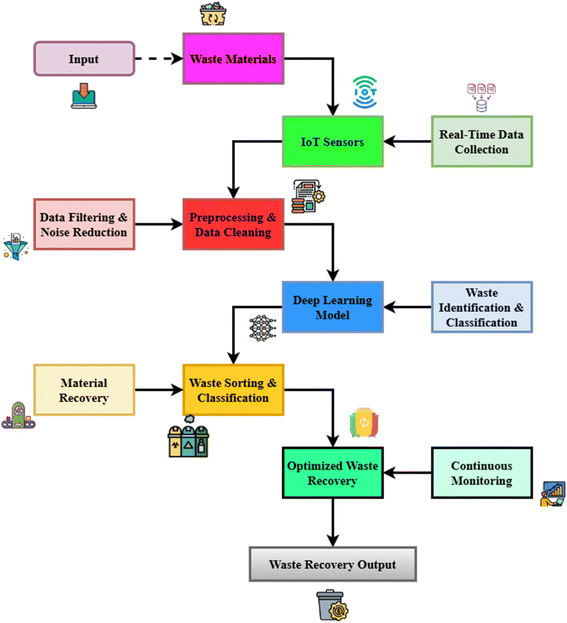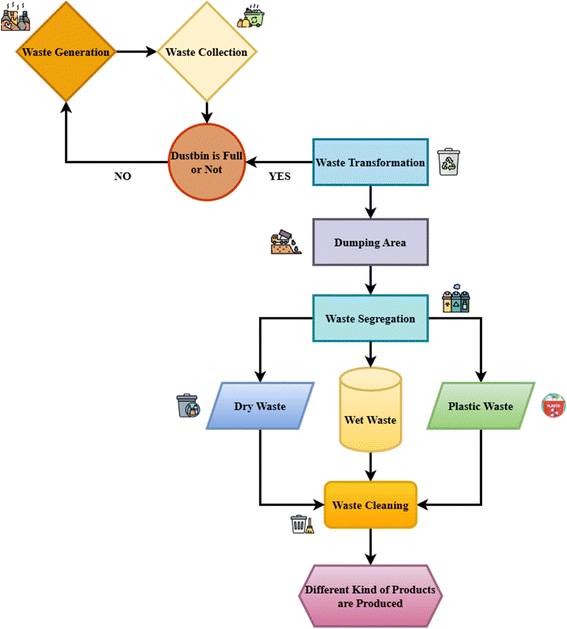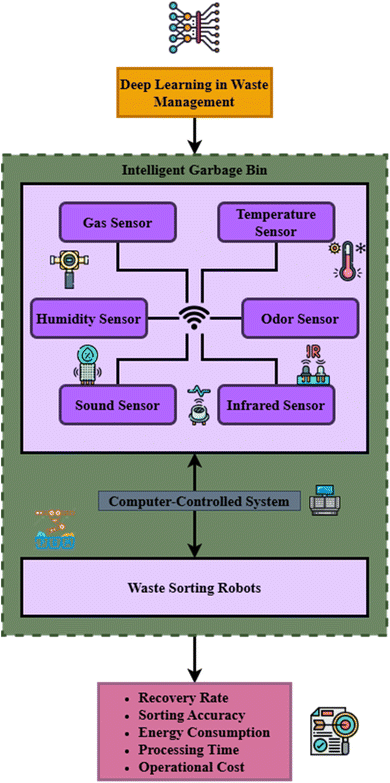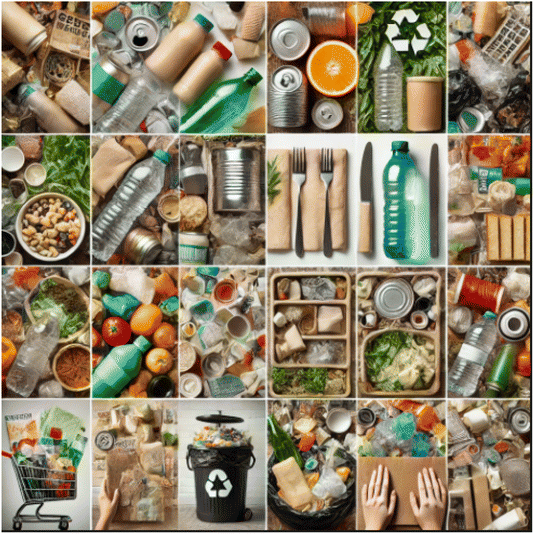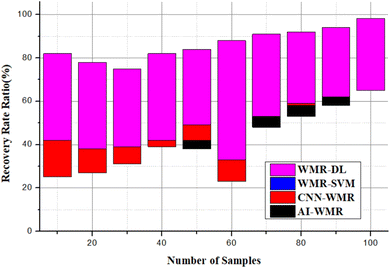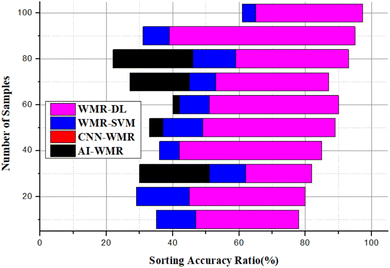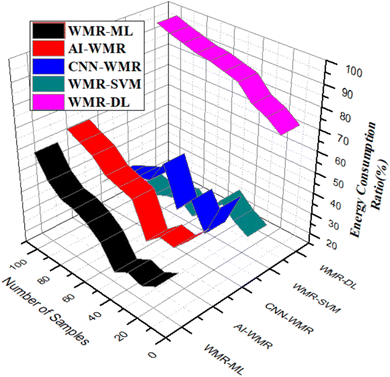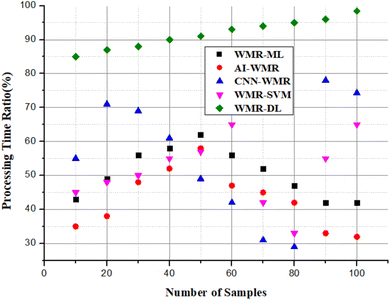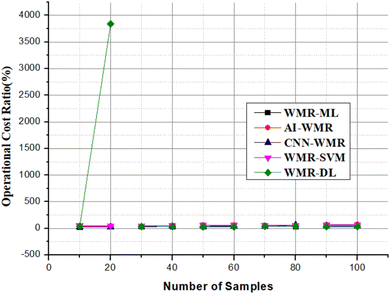 Open Access Article
Open Access ArticleCreative Commons Attribution 3.0 Unported Licence
Investigation of a deep learning-based waste recovery framework for sustainability and a clean environment using IoT
M.
Arun
 *
*
Department of Mechanical Engineering, Saveetha School of Engineering, Saveetha Institute of Medical and Technical Sciences (SIMATS), Thandalam, 602105, India. E-mail: arunkarthik116@gmail.com
First published on 26th February 2025
Abstract
The growing concern over environmental sustainability has prompted the development of various technologies for waste material recovery and management. One promising approach involves leveraging Internet of Things (IoT) platforms combined with deep learning (DL) models to enhance the efficiency and effectiveness of waste recovery systems. Due to manual processes and limited automation, waste recovery methods face challenges such as inadequate waste sorting, high energy consumption, and low recovery rates. These methods often struggle to scale effectively, leading to inefficiencies in waste management and sustainability efforts. The proposed framework, Waste Material Recovery using Deep Learning (WMR-DL), aims to address these issues by integrating IoT sensors for real-time data collection and deep learning algorithms for automated waste identification and classification. This system improves sorting accuracy, reduces human intervention, and enhances the recovery of valuable materials from waste. The IoT platform allows for continuous monitoring, while deep learning models analyze data to predict and optimize the waste recovery process. The proposed method can be applied in various waste management sectors, such as recycling plants, e-waste recovery, and municipal waste systems. The system supports intelligent decision-making using IoT-enabled devices and DL models, optimizing real-time waste sorting and material recovery processes. Preliminary findings show that the WMR-DL framework improves recovery efficiency by up to 30%, with reduced operational costs and better resource management. This approach promotes sustainability and significantly reduces the environmental impact of waste disposal systems, contributing to a cleaner and greener environment.
Sustainability spotlightThis work contributes to advancing sustainability by promoting Total Quality Management (TQM) practices that optimize resource use, reduce waste, and foster long-term environmental and social responsibility. By focusing on continuous improvement, supplier partnerships, and customer satisfaction, it aligns with the UN's Sustainable Development Goal (SDG) 12: responsible consumption and production. Through methodologies such as Six Sigma, Kaizen, and Lean, the work emphasizes efficiency and waste reduction, enabling businesses to minimize their environmental footprint. Additionally, the integration of ISO 14000 standards reinforces the commitment to sustainable management practices, supporting SDG 13: climate action. This holistic approach empowers organizations to balance economic growth with sustainability, fostering a culture of innovation and ethical responsibility. |
1. Introduction
The combination of ICT, IoT, and DL sets the contours of modern urban development.1 In this context, smart cities have emerged as a technical revolution to raise living standards, reduce environmental impacts, and optimize resource use.2 Waste management is a critical part of smart city initiatives, and the issue of integrating ICT, IoT, and DL has very important implications here.3 A smart city uses highly advanced technology to improve urban life. It uses advanced technology in administration processes to minimize inefficiencies.4 Sensor nodes, wireless networks, applications for information systems, and integrated communication protocols are some of the elements of smart cities.5 When integrated, these provide a networked and engaging urban landscape where various components can interact in real time.6Improving the quality of life for inhabitants is one of the major goals of the smart city movement while reducing the incidence and amount of expensive infrastructure improvements.7 A smart city project cannot be complete without efficient trash management.8 In addition to enhancing quality of life, a well-executed waste management system helps create a healthy and attractive urban environment.9 The waste management system primarily supports the disposal and treatment of various kinds of waste. It protects humans, animals, and the environment.10 Better air quality and reduced environmental contamination are possible outcomes of cost-effective waste management strategies.11 At the same time, developed areas are finding and using effective methods for waste management, and the consequences are very positive.12
Given the existing state of affairs, it will be next to impossible to handle such a massive quantity of garbage in the next five years.13 To effectively manage waste, it is preferable to do everything needed to maintain a healthy environment; we must use the most effective methods and procedures for efficiently treating garbage.14 Using a waste management system based on the IoT and DL is the most effective way to solve the issue of environmental pollution.15 These innovations may optimize the route of garbage trucks and provide real-time data on trash, cutting down on both time and money spent on the process.16 The problems with the present waste management systems come from incorrect scheduling, which means that the people responsible for collecting the trash are unaware they are required to do it.17 Internet of Things innovation has become an effective tool for developing smart urban communities, and it is one of the very important applications.18 The growth of waste material output with the acceleration of population growth in cities has been one of the critical concerns for a smart city.19
1.1 Motivation
The demand for improved and environment-friendly waste management led to the development of this Waste Material Recovery using the Deep Learning (WMR-DL) framework. The current systems, which offer low recovery rates and too much energy consumption, are also plagued by poor sorting since they are either manually operated or, in most cases, minimally automated. Using the IoT and deep learning, WMR-DL is an automatic, scaled approach to waste recovery improvement with reduced environmental influence.1.2 Main problem
The primary causes of high operating costs, low rates of recovery of materials, and inefficient sorting prevailing in most of today's waste management systems are manual operations and a lack of automation. The constraints thus imposed limit the scale and sustainability of waste recovery. This motivation was to create a better, technology-driven framework for increasing sorting efficiency while simultaneously reducing energy use and maximizing recovery rates.Contributions of this paper:
• Integration of IoT and deep learning: the paper introduces an innovative framework combining IoT sensors and deep learning models to automate and optimize waste material sorting and recovery processes for enhanced sustainability.
• Improved waste recovery efficiency: the proposed system significantly increases material recovery rates by automating waste classification, reducing human intervention, and optimizing resource utilization in recycling and waste management operations.
• Real-time data processing and monitoring: the framework utilizes IoT platforms for continuous monitoring and deep learning for data-driven decision-making, improving operational efficiency and reducing environmental impact in waste management systems.
The remainder of this paper is structured as follows: in Section 2, the waste material recovery is studied. In Section 3, the proposed methodology of WMR-DL is explained. In Section 4, the efficiency of WMR-DL is discussed and analyzed. Finally, in Section 5, the paper concludes with future work.
2. Related work
Planning the routes of garbage trucks is an ongoing part of trash management in urban areas that requires consideration of economic, social, and environmental factors. The length has to be shortened using the diagram hypothesis to reduce the required effort and avoid expensive fuel. To help with decision-making, a few companies have used Internet of Things (IoT) devices to measure the contents of boxes and publish the results online.Traditional approaches to treating and recycling organic solid waste have many problems, including inefficiency, inaccurate results, high costs, and possible environmental harm. Machine learning has been gaining traction over the last decade as a potential solution to the challenging issues surrounding the treatment of organic solid waste by Guo H. N. et al.20 Even though a lot of research has been done, the results of that study have not been systematically reviewed. The constraints and future possibilities of relevant applications highlight various machine learning models' domains of use, features, and appropriateness. The recovery rate is very low, at 50.12% in WMR-ML.
The potential future of AI and robotics in the United States recycling industry involves exploring several legislative scenarios and their effects on human labour. As a result of technological and economic advancements, recycling and the people who engage in it are experiencing fast transformations, and the industry is adapting to these changes. Examining various technological solutions for recyclable sorting at material recovery facilities, Chertow M. et al.21 outlined the policy, social, and technical factors that impact MSW management in the United States and investigate potential approaches to achieving more sustainable results. The sorting accuracy is very low, at 45.23%, in AI-WMR.
Sorting garbage into its many components is known as trash sorting. The present fad is to sort trash effectively so that it may be handled properly. It wants to keep other items out of the trash and separate them as soon as feasible. Waste management firms benefit greatly from the need to automate this procedure. This study hopes to automate waste sorting by applying machine learning approaches to identify the kind of garbage only from photographs. It used two well-known CNN learning algorithms reported by Sakr G. E. et al.22 The energy consumption is very poor, at 38.1% in CNN-WMR.
Concerns about flood control have grown with the likelihood of catastrophic rainfall events due to climate change. It is critical to have accurate predictions of flood waste to recover fast after flood damage and avoid more consequential harm. To lessen the impact of disasters, it is crucial to create a system that can accurately and quickly forecast the amount of garbage generated by floods by Fatovatikhah F. et al.23 While several academics have offered methods for categorizing flood debris, very few have concentrated on methods for predicting flood debris. The processing time is low at 39.26% in WMR-SVM.
According to the disposal statistics, there are noticeable seasonal differences; for example, in the summer, the MWD is 417.8 t per month, while in the winter, it is around 289.7 t per month. The seasonal variations of MWD are distinct as well. The least variance was seen in winter, perhaps because people's lives were similar. The skewness is greatest in the summer, although it is negative for all seasons. The model performs well using all available data, with R2 values ranging from 0.72 to 0.86. It seems that the modelling of garbage disposal rates is heavily influenced by meteorological seasons according to Adusei K. K. et al.24 The operational cost is very high, at 75.64% in LSTM-WMR.
Most domestic and international studies on the e-waste reverse resource network have relied only on conventional forward logistics, and the field is still in its early stages. Moving products away from their usual end destination to recover their recycling value or dispose of them correctly is known as reverse resources. The government's efforts to enhance environmental protection laws and the fierce competition in the market have elevated reverse resources from an overlooked link in the supply chain according to Li C. et al.25 (Table 1).
| S. no. | Methods | Advantages | Limitations |
|---|---|---|---|
| 1 | Machine learning (WMR-ML) | Enhances sorting accuracy, reduces costs, improves efficiency | Limited systematic reviews; application constraints |
| 2 | Artificial intelligence (AI-WMR) | Automates recycling, supports labour reduction | Dependency on legislative support; high initial costs |
| 3 | Convolutional neural networks (CNN-WMR) | Effective for image-based waste sorting, reduces sorting time | Limited to visual recognition; requires large datasets |
| 4 | Support vector machine (WMR-SVM) | Useful for specific event-based waste prediction (e.g., floods) | Limited generalization across waste types requires fine-tuning |
| 5 | Long short-term memory (LSTM-WMR) | Accurately models seasonal waste variations, adapts to time series data | High computational demand; limited interpretability |
| 6 | Recurrent neural network (RNN-WMR) | Supports reverse logistics in e-waste, enhances material recovery | The early stage of waste management requires large-scale data |
In conclusion, waste material recovery by machine learning and artificial intelligence has advanced significantly in response to the growing wave of issues pertaining to ecological sustainability and waste management. Automating garbage sorting, improving recycling operations, and forecasting garbage creation are all areas where ML models like CNN, SVM, and RNN have shown potential. According to studies, these techniques can address urgent waste management concerns in several industries. They can enhance sorting accuracy, decrease manual labour, and boost sustainability initiatives.
3. Proposed method
Rising environmental concerns stimulate the advancement of innovations in waste management and enhance the practice of sustainability. WMR-DL relies upon sensors employed by IoT and deep learning algorithms that enable fully autonomous sorting of waste, supporting rising material recovery rates with improved efficiency and environmental sustainability.3.1 Integration of IoT and deep learning
The proposed WMR-DL framework integrates IoT sensors and deep learning to process waste recovery efficiently. The resultant process can identify and sort automatically waste. Such methods eliminate inefficiency in manual processes for higher accuracy and material recovery rate.Fig. 1 illustrates the proposed system, where an IoT-enabled machine learning system is designed to improve the waste management process with data-driven insights. Based on the system, the central component is the server that accommodates multiple machine learning algorithms based on analyzing waste-binned data collected via sensors. Organized and processed, these data are kept in a central database for later use under the guidance of an organization algorithm. The machine learning component enables data management and information forwarding, sending real-time waste status updates to end users.
A visualization interface is provided for end users to access this information for waste collection and management decision-making processes. Levels of waste and collections are informed to the waste collection truck, and the collection route and time are optimized. Each waste bin is equipped with sensors, a controller, and network access through battery power for connectivity and real-time communication over the internet. It offers an intelligent route to ecological waste management through effective observing and collecting strategies.
| ∂v′ − Fw(L − vxw′′):→ F − [Nt(∂ + wab′′)] | (1) |
The relationship Fw indicates the difference between material recovery rates F and forces, such ∂v′, as it pertains to trash sorting (L − vxw′′) and optimization Nt driven by deep learning ∂ + wab′′. An automated and more sustainable waste management system might be achieved by maximizing material recovery efficiency using eqn (1).
 | (2) |
According to eqn (2), optimization adjustments (N(Tr − Fq′′)) and the rate of waste recovery  are determined by real-time sensor input Va and predictions 4y − qb′′ made by deep learning. By integrating the Internet of Things (IoT) with deep learning (DL), this equation shows how the system reacts to changing operating parameters.
are determined by real-time sensor input Va and predictions 4y − qb′′ made by deep learning. By integrating the Internet of Things (IoT) with deep learning (DL), this equation shows how the system reacts to changing operating parameters.
| ∝v[P − wq′′] + Fv〈P − qt′′ + Kpt′′〉 | (3) |
The suggested technique is supported by eqn (3), which optimizes ∝v the recovery process P − wq′′ by depicting the interaction Fv between the input material properties P − qt′′, deep learning classification (Kpt′′), and system parameters. To enhance sorting accuracy and efficiency in garbage recovery, the IoT platform and deep learning algorithms make real-time modifications, as shown by this equation.
Fig. 2 shows a layered approach of the WMR-DL framework to optimize waste recovery in an IoT-integrated and deep learning-based system. As seen in the flow followed in Fig. 2, the system begins with the sensor-activated collection of real-time data about the waste's type, level, and other environmental parameters. It moves to the data collection and IoT layer, which carries out the forwarding and streaming of data toward further processing.
Data preprocessing and cleaning give raw data; therefore, cleaning and filtering are used for analysis in the deep learning model layer. Deep learning algorithms classify and determine waste materials in the system to sort correctly. Through the material recovery and recycling layer, the result of processed data is that valuable materials are separated and recovered.
The insights and dashboard layer generates outputs, so constant monitoring and optimization occur. The feedback and control layer is a fine-tuning process that supports a sustainable and efficient waste management system to attain recovery accuracy and efficiency of waste, along with a stimulus towards environmental sustainability.
| F(P − wat′) = Kl〈Out′ − Wpr′′〉 | (4) |
The waste categorization parameters Out′ and pressure (F(P − wat′)) are taken into account in eqn (4). It aligns with the way deep learning models modify garbage sorting outputs Kl using real-time data Wpr′′ from the Internet of Things (IoT) sensors and improved recovery procedures within the framework of the suggested approach. This equation ensures that the system adjusts effectively with minimal energy and maximum material recovery.
 | (5) |
The parameters for waste classification P − wqt′′ and pressure (Or) are used in eqn (5), which modifies the output  The suggested approach uses deep learning models to minimize operational losses (Qr′) by dynamically adjusting waste sorting and material recovery efficiency (Lpf′′) in response to real-time sensor data. Improved recovery rates and lower energy costs are the end goals of this system optimization and balancing process.
The suggested approach uses deep learning models to minimize operational losses (Qr′) by dynamically adjusting waste sorting and material recovery efficiency (Lpf′′) in response to real-time sensor data. Improved recovery rates and lower energy costs are the end goals of this system optimization and balancing process.
Vf{P − ntr′′ + 2aq′′}:→ tan![[thin space (1/6-em)]](https://www.rsc.org/images/entities/char_2009.gif) U〈P − aq′′〉 U〈P − aq′′〉 | (6) |
The efficiency of the system may be dynamically adjusted by optimization factors P − aq′′, waste classification (Vf) and (P − ntr′′), and pressure ({P − ntr′′ + 2aq′′}:→). Eqn (6) (tan![[thin space (1/6-em)]](https://www.rsc.org/images/entities/char_2009.gif) U) connects system factors such as energy consumption and classification thresholds within the framework. Its goal is to improve the waste recovery process's overall sustainability and efficiency by optimizing the system's output via continual parameter adjustment.
U) connects system factors such as energy consumption and classification thresholds within the framework. Its goal is to improve the waste recovery process's overall sustainability and efficiency by optimizing the system's output via continual parameter adjustment.
3.2 Improved waste recovery efficiency
WMR-DL integrates IoT devices for real-time waste monitoring, deep learning models, and data-driven sorting. This implementation automatically facilitates sorting processes, limits potential human interference with the process, and allows the system to adapt to all industries dealing with waste, like recycling or municipal waste.Fig. 3 shows the step-by-step flow process of the WMR-DL framework, showing each phase in wasting recovery optimization. The process begins with the input of waste materials under the monitoring of IoT sensors that enable real-time data collection. The initial data are then filtered, cleaned and preprocessed to remove noise and improve quality input for analysis.
The deep learning model seeks algorithms that classify waste, allowing waste identification and classification. The classified information from the system is passed to waste sorting and classification, where materials are categorized based on potential recovery. Its material recovery stage extracts valuable materials and optimizes waste recovery, during which the system refines recovery operations intended to maximize efficiency.
It tracks the process under continuous monitoring, and waste recovery output contributes to a more sustainable approach to handling all the waste. The structured flow supports the automation of waste sorting and ensures a cleaner environment.
| ∝l−v × Rq′′[P − vrt′′]:→ Nv{P − vtr′′ + zq′′} | (7) |
In the waste recovery process zq′′, the function ∝l−v, Rq′′ depicts the link between the dynamic modifications P − vtr′′ of deep learning models, pressure (P − vrt′′), and waste classification efficiency (Nv). Eqn (7) is related to maximizing material recovery via input parameter balancing in the context of the suggested strategy.
| O{Yw{P − wq′ + 4rt′′}}:→ Nk〈I − qwt′′〉 | (8) |
Eqn (8) shows how to optimize Nk the waste recovery outputs O using deep learning models by modifying I − qwt′′ system parameters like pressure (Yw) and waste classification factors (P − wq′, 4rt′′). This equation aims to improve system efficiency via input balance and optimization of recovery rates.
| δb − Vh〈Pi − sq′′ + Da′′〉:→ Vza′′〈K − jt′′〉 | (9) |
In the process of waste recovery Vza′′, eqn (9) represents K − jt′′ for the following variables: waste input parameters (Pi − sq′′), deep learning classification factors (δb − Vh) and system optimization variables (Da′′). Taking into account both sensor data and deep learning predictions, improved trash sorting accuracy and material recovery may be achieved by balancing several operating factors.
Fig. 4 depicts waste flow and transformation using WMR-DL. The process starts with waste generation followed by waste collection IoT-enabled monitoring checks whether the dustbin is full, if full waste is directed towards waste transformation and transferred to a dumping area.
In the waste segregation stage, collected waste is classified into three parts: dry waste, wet waste, and plastic waste, depending on the properties of the materials. Waste cleaning, one of the steps in removing contamination, prepares waste for transformation. Sorted and cleaned waste can be employed to manufacture various types of products. This increases material recovery, making resources more efficient in the long run.
It ensures proper segregation and cleaning, thus optimizing recovery efficiency. Such a procedure encourages material efficiency reuse; therefore, environmental impact is reduced and sustainability is enhanced. Integrating IoT and deep learning improves the accuracy and efficiency of sorting and operation.
| N(Pv′ − Wq′′ + 〈HjT − lu′′〉):→ Ma〈P − twq′′〉 | (10) |
The optimization of waste recovery outcomes (N) is represented by eqn (10), which takes P − twq′′ into account along with system parameters such as pressure Pv′ − Wq′′, waste classification as driven by deep learning (HjT − lu′′) and real-time feedback adjustments (Ma). This equation aims to optimize system performance by reducing operational inefficiencies and balancing inputs to improve the waste recovery process's sustainability.
| 4f〈l−TQ′〉 → Nj′ − 〈O − twq′′ + Mlp′′〉 | (11) |
Using deep learning models Mlp′′, eqn (11) depicts the link between waste sorting efficiency (Nj′), material classification accuracy (4f〈l−TQ′〉), and optimization of the recovery system (O − twq′′). This equation maximizes waste material recovery by maintaining a constant equilibrium between the system's inputs and outputs in real time in the recovery rate analysis.
| ∝lp − Sq′′ → Np′ − 〈Dq′ − Tyw′′ + Lb′′〉 | (12) |
The optimization factors ∝lp − Sq′′, waste classification parameters (Dq′ − Tyw′′), and system Lb′′ efficiency variables (Np′) are represented by eqn (11). This equation is related to material recovery and real-time trash sorting using Internet of Things (IoT) sensors and deep learning models to analyze sorting accuracy.
3.3 Real-time data processing and monitoring
WMR-DL has quantitatively evaluated efficiency and demonstrated a further enhancement of 30% efficiency in waste recovery using derived efficiency and recovery rate equations. This shall be achieved to validate the approach and prove that the proposed framework will lead to cost reduction and sustainability.The proposed system for waste management is depicted in Fig. 5: IoT sensors and deep learning to optimize waste sorting and recovery. The intelligent garbage bin contains multiple IoT sensors with infrared sensors, including gas, temperature, humidity, odour, and sound sensors, thereby continuously conveying real-time data. These are transmitted to a computer-controlled system that has these data processed by deep learning models for the identification and classification of various types of waste. The system also comprises waste-sorting robots that execute automated sorting according to the sensor data, optimizing the sorting accuracy and minimizing human intervention.
Such a system would make the recovery rate, sorting accuracy, energy consumption, time taken for processing, and operational cost its performance metrics. This intelligent approach would benefit waste management, enhance material recovery, reduce energy use, and decrease machinery costs to create an enviable environment.
| O(L − wt′):→ K(∝Vf′ − Xb′′) + Ltw〈K − q′vf〉 | (13) |
The optimization of waste recovery output (O) is shown by eqn (13), which uses deep learning models Ltw to modify system parameters K − q′vf such as pressure K(∝Vf′ − Xb′′) and material classification (L − wt′). Optimization of recovery efficiency is the goal of this equation, which maintains a constant equilibrium between input data, system modifications, and energy use for analysis of energy consumption.
| ρπ[τ + ω′′]:→ μ′ + Qa[L − tr′ + cvt′′] | (14) |
The optimization of waste recovery Qa is shown by eqn (14), which takes into account characteristics L − tr′ such as waste categorization ρπ[τ + ω′′] and real-time modifications μ′ + Qa. The emphasis is on enhancing efficiency via system feedback and cvt′′. This equation improves recovery efficiency by dynamic parameter adjustment to analyze processing time.
| J{Pit′ − Vfd}:→ Mk〈P − qw′ +∪r′′〉 | (15) |
This eqn (15) is solved +∪r′′ using deep learning models J and includes variables P − qw′ like classification (Pit′ − Vfd) and pressure (Mk). This equation corresponds to optimizing trash sorting and recovery in real time, regarding the suggested operational cost analysis strategy.
This is an integration of IoT and deep learning techniques for optimized waste recovery to allow for a significant reduction in the proportion of losses due to manually collected products. This framework, hence, could maximize sorting accuracy while minimizing production costs due to reduced operational costs, among other things. It would further contribute toward more sustainable practices through proper management and reserve resource utilization and also minimize the environmental impact.
4. Results and discussion
The WMR-DL framework helps improve the efficiency and accuracy of garbage sorting and recovery operations by combining Internet of Things sensors and deep learning models. It reduces operating costs, energy consumption, and human intervention in garbage sorting. The performance of the proposed WMR-DL model has been analyzed based on metrics such as recovery rate, sorting accuracy, energy consumption, processing time, and operational cost compared with existing models WMR-SVM, LSTM-WMR, and RNN-WMR.4.1 Dataset description
This dataset26 includes 15![[thin space (1/6-em)]](https://www.rsc.org/images/entities/char_2009.gif) 000 photos taken under 30 categories: recyclable, household waste, and mixed litter. Each image size is 256 by 256 pixels. With 500 photos in every category and 250 photos in each subcategory, the dataset will greatly benefit the research and development of garbage categorization and recycling disciplines. The goal of this dataset is to allow the building of reliable and accurate garbage sorting and classification algorithms with a large number of high-quality photos (Table 2).26Fig. 6 shows the different categories of waste.
000 photos taken under 30 categories: recyclable, household waste, and mixed litter. Each image size is 256 by 256 pixels. With 500 photos in every category and 250 photos in each subcategory, the dataset will greatly benefit the research and development of garbage categorization and recycling disciplines. The goal of this dataset is to allow the building of reliable and accurate garbage sorting and classification algorithms with a large number of high-quality photos (Table 2).26Fig. 6 shows the different categories of waste.
| Metrics | Description |
|---|---|
| Dataset size | 15![[thin space (1/6-em)]](https://www.rsc.org/images/entities/char_2009.gif) 000 images across 30 categories 000 images across 30 categories |
| Image dimensions | 256 × 256 pixels |
| Categories | 30 categories (recyclables, general rubbish, home goods) |
| Dataset purpose | To develop accurate garbage sorting and classification algorithms |
| Applications | Waste management, recycling, automated sorting systems |
| Data quality | High-quality, diverse images for reliable algorithm development |
| Tools for simulation | Python, TensorFlow, Keras, OpenCV, Scikit-learn |
The WMR-DL framework sets the recovery rates and indicates that with that approach, conventional limitations have been overcome to become very effective in improving the efficiency of waste recovery. Early results show that WMR-DL improves recovery rates and requires less human involvement with the right waste sorting, as described in eqn (11). It enhances the recovery of materials by sorting valuable sources from waste through deep learning algorithms for waste classification processes and real-time monitoring through IoT sensors. The more precise the processes, the lower the costs of processing and the higher the recovery rates without wasting such massive resources. Maximizing the retrieval of recoverable material lines up with environmental sustainability goals, and the higher recovery rate indicates more environmentally friendly waste management that lessens the need for landfill disposal. Fig. 7 indicates that the recovery rate reached 98.23%.
The WMR-DL framework uses state-of-the-art deep learning algorithms with IoT sensors to improve sorting accuracy. Using real-time data from IoT devices, the system accurately and efficiently sorts garbage by identifying and classifying different types of materials, as explained in eqn (12). This replaces labour-intensive and error-prone manual sorting methods. Accurate categorization of various waste categories, including recyclable plastics and electronic garbage, is made possible by fast and adaptable data processing using deep learning algorithms. Lowering contamination in sorted materials and increasing recovery rates enhance precision and maximize the value and quality of recovered resources, while minimizing the environmental effect of waste mismanagement. The sorting accuracy ratio is improved by 97.22%, as shown in Fig. 8.
Trash material recovery with deep learning automates and optimizes the trash sorting process, drastically reducing energy usage. Manual sorting requires a lot of energy, and traditional techniques generally use inefficient technology that runs all the time without changing to accommodate real-time circumstances, as explained in eqn (13). By using deep learning models and Internet of Things sensors, WMR-DL optimizes processes, reducing energy waste by only engaging sorting mechanisms when needed. The technology prevents unnecessary energy use and operational effort by processing data on garbage categorization in real time. Energy reductions have the dual benefit of lowering expenses and reducing environmental impact, which is great news for sustainable waste recovery techniques. The energy consumption ratio reaches 96.45%, as shown in Fig. 9.
The processing time for Waste Material Recovery using Deep Learning (WMR-DL) is much lower than that of conventional waste recovery technologies. Conventional sorting methods are either labour-intensive and error-prone or depend on outdated and inefficient automated techniques, as explained in eqn (14). On the other hand, WMR-DL quickly sorts and classifies trash using deep learning algorithms and Internet of Things sensors to collect data in real time. Quicker decisions and material recovery result from our real-time analysis, simplifying sorting. Better waste management operations, faster turnaround times, and higher throughput are all outcomes of optimizing processing time. The processing time ratio reaches 98.41%, as shown in Fig. 10.
Waste material recovery uses deep learning architecture to account for a significant proportion of innovation costs in waste management. While extensive physical work, costly machinery restoration, and power consumption are used in processes and operations as described by eqn (15), the WMR-DL framework uses deep learning models and Internet of Things sensors to automatically sort garbage out, thereby minimizing reliance on human labor while reducing the need for equipment restoration. Reduced waste mismanagement with an increased resource recovery rate leads to reduced disposal costs due to the system's optimization of sorting accuracy and processing efficiency. Overall, this process is much more cost-effective and environmentally friendly than the old methods of trash recovery. The operational cost is reduced by 30%, as shown in Fig. 11 and Table 3.
| Aspects | Key features | Existing methods (%) | Proposed methods (%) |
|---|---|---|---|
| Recovery rate | Lower impact with improved material recovery | 50.12% | 98.23% |
| Sorting accuracy | High, automated waste classification | 45.23% | 97.22% |
| Energy consumption | Optimized, reduced by real-time process control | 38.1% | 96.45% |
| Processing time | Faster due to real-time data analysis | 39.26% | 98.41% |
| Operational costs | Reduced through automation and optimized processes | 75.64% | 30% |
In summary, by collecting data in real time and using sophisticated algorithms, WMR-DL improves waste recovery, increasing recovery rates while decreasing environmental effects. This framework promotes sustainable and cost-effective waste management across numerous industries.
A model may reduce the retraining time on new datasets by using transfer learning to use pre-trained information from one domain and apply it to other tasks, such as e-waste recovery or hazardous item detection. This method improves the model's capacity to scale and perform well in various environments. Similarly, dynamic waste recovery systems may optimize decision-making processes by integrating reinforcement learning. To adapt to changing situations, including changes in waste composition or configurations of recovery systems, the model may learn the best actions for resource recovery by continually engaging with real-time data from the IoT. Improved accuracy with minimal task-specific data is achieved by transfer learning, which enables the model to use information from pre-trained models. These models may be fine-tuned for particular waste recovery activities. Making use of previously learnt characteristics shortens the training time while increasing performance. Alternatively, reinforcement learning may improve the system's decision-making via ongoing learning from real-time interactions with the IoT platform. The model improves its capacity to handle complicated situations, including fluctuations in waste kinds and recovery effectiveness, by obtaining feedback and incentives for appropriate behaviours, allowing it to adapt to dynamic surroundings.
5. Conclusion
The Internet of Things and deep learning may be used for smart garbage management. This approach ensures that trash is collected as soon as it reaches its maximum amount. The system's efficiency will increase because of the accurate reports it generates. A smart waste management system that considers the idea of integrated, sustainable waste management should be developed. Public health might be impacted by various dangers resulting from landfill closures. Environmental pollution and several dangerous illnesses may result from open junkyards and the burning of unwanted rubbish. An efficient system for managing garbage collection and disposal and controlling the overall increase of solid waste should be implemented. Our suggested approach is more efficient than competing garbage collection and treatment models. Time and money saved on gas are two more benefits. The technology also monitors trash trucks, increasing productivity by providing real-time information on the vehicle's whereabouts. Prior waste management models have neglected the time and money needed to implement the system as a whole in favour of a singular emphasis on sustainability. However, our trash management method is eco-friendly and reduces setup expenses and time. The system forecasted a specific dumping ground's trash index using image processing. The garbage trucks will gather trash promptly by sorting it by importance. WMR-DL presents a waste management system model that incorporates several stakeholders, including smart bins, sensors at the source area, and vehicles. Due to the dynamic updating of smart bins, collection trucks, and routes, the system is efficient and effective.5.1 Future work
Improving environmental sustainability will be the primary goal of future efforts to extend the WMR-DL framework to other forms of trash, including hazardous and medical waste. Improving sorting accuracy via deep learning algorithm refinement, including more advanced Internet of Things sensors, and investigating real-time predictive maintenance are all examples of future developments. The scalability, flexibility, and cost-effectiveness will be evaluated via large-scale pilot operations in various waste management contexts.Data availability
The data will be available upon request.Conflicts of interest
There are no conflicts to declare.References
- K. Lin, Y. Zhao, J. H. Kuo, H. Deng, F. Cui, Z. Zhang, M. Zhang, C. Zhao, X. Gao, T. Zhou and T. Wang, Toward smarter management and recovery of municipal solid waste: a critical review on deep learning approaches, J. Cleaner Prod., 2022, 346, 130943 CrossRef CAS.
- M. Arun, D. Barik, S. S. Chandran, S. Praveenkumar and K. Tudu, Economic, policy, social, and regulatory aspects of AI-driven smart buildings, J. Build. Eng., 2025, 99, 111666 CrossRef.
- M. Arun, D. Barik, S. S. Chandran, S. Praveenkumar and K. Tudu, Economic, policy, social, and regulatory aspects of AI-driven smart buildings, J. Build. Eng., 2025, 99, 111666 CrossRef.
- J. Bobulski and M. Kubanek, Deep learning for plastic waste classification system, Applied Computational Intelligence and Soft Computing, 2021, 2021(1), 6626948 Search PubMed.
- M. Arun, D. Barik and S. S. Chandran, Exploration of material recovery framework from waste–a revolutionary move towards clean environment, Chem. Eng. J. Adv., 2024, 18, 100589 CrossRef.
- M. Malik, S. Sharma, M. Uddin, C. L. Chen, C. M. Wu, P. Soni and S. Chaudhary, Waste classification for sustainable development using image recognition with deep learning neural network models, Sustainability, 2022, 14(12), 7222 CrossRef CAS.
- L. W. Ming, J. Anderson, F. Hidayat, F. D. Yulian and N. Septiani, AI as a driver of efficiency in waste management and resource recovery, International Transactions on Artificial Intelligence, 2024, 2(2), 128–134 Search PubMed.
- H. Khayyam, M. Naebe, A. S. Milani, S. M. Fakhrhoseini, A. Date, B. Shabani, S. Atkiss, S. Ramakrishna, B. Fox and R. N. Jazar, Improving energy efficiency of carbon fiber manufacturing through waste heat recovery: a circular economy approach with machine learning, Energy, 2021, 225, 120113 CrossRef.
- W. Xia, Y. Jiang, X. Chen and R. Zhao, Application of machine learning algorithms in municipal solid waste management: a mini review, Waste Manage. Res., 2022, 40(6), 609–624 CrossRef PubMed.
- A. K. Sharma, P. K. Ghodke, N. Goyal, S. Nethaji and W. H. Chen, Machine learning technology in biohydrogen production from agriculture waste: recent advances and future perspectives, Bioresour. Technol., 2022, 364, 128076 CrossRef PubMed.
- L. Yang, H. Nguyen, X. N. Bui, T. Nguyen-Thoi, J. Zhou and J. Huang, Prediction of gas yield generated by energy recovery from municipal solid waste using deep neural network and moth-flame optimization algorithm, J. Cleaner Prod., 2021, 311, 127672 CrossRef.
- M. Erkinay Ozdemir, Z. Ali, B. Subeshan and E. Asmatulu, Applying machine learning approach in recycling, J. Mater. Cycles Waste Manage., 2021, 23, 855–871 CrossRef.
- M. Koskinopoulou, F. Raptopoulos, G. Papadopoulos, N. Mavrakis and M. Maniadakis, Robotic waste sorting technology: toward a vision-based categorization system for the industrial robotic separation of recyclable waste, IEEE Robotics & Automation Magazine, 2021, 28(2), 50–60 Search PubMed.
- C. P. Ginga, J. M. Ongpeng and M. K. Daly, Circular economy on construction and demolition waste: a literature review on material recovery and production, Materials, 2020, 13(13), 2970 CrossRef CAS PubMed.
- P. Davis, F. Aziz, M. T. Newaz, W. Sher and L. Simon, The classification of construction waste material using a deep convolutional neural network, Autom. Constr., 2021, 122, 103481 CrossRef.
- D. Demetriou, P. Mavromatidis, P. M. Robert, H. Papadopoulos, M. F. Petrou and D. Nicolaides, Real-time construction demolition waste detection using state-of-the-art deep learning methods; single-stage vs. two-stage detectors, Waste Manage., 2023, 167, 194–203 CrossRef PubMed.
- H. Wilts, B. R. Garcia, R. G. Garlito, L. S. Gómez and E. G. Prieto, Artificial intelligence in the sorting of municipal waste as an enabler of the circular economy, Resources, 2021, 10(4), 28 CrossRef.
- N. Kroell, X. Chen, K. Greiff and A. Feil, Optical sensors and machine learning algorithms in sensor-based material flow characterization for mechanical recycling processes: a systematic literature review, Waste Manage., 2022, 149, 259–290 CrossRef PubMed.
- B. Fang, J. Yu, Z. Chen, A. I. Osman, M. Farghali, I. Ihara, E. H. Hamza, D. W. Rooney and P. S. Yap, Artificial intelligence for waste management in smart cities: a review, Environ. Chem. Lett., 2023, 21(4), 1959–1989 CrossRef CAS PubMed.
- H. N. Guo, S. B. Wu, Y. J. Tian, J. Zhang and H. T. Liu, Application of machine learning methods for the prediction of organic solid waste treatment and recycling processes: a review, Bioresour. Technol., 2021, 319, 124114 CrossRef CAS PubMed.
- M. Chertow, B. K. Reck, A. Wrzesniewski and B. Calli, Outlook on the future role of robots and AI in material recovery facilities: implications for US recycling and the workforce, J. Cleaner Prod., 2024, 470, 143234 CrossRef.
- G. E. Sakr, M. Mokbel, A. Darwich, M. N. Khneisser and A. Hadi, Comparing deep learning and support vector machines for autonomous waste sorting, in 2016 IEEE International Multidisciplinary Conference on Engineering Technology (IMCET), IEEE, 2016, vol. 2, pp. 207–212 Search PubMed.
- F. Fatovatikhah, I. Ahmedy and R. M. Noor, Waste Prediction Approach Using Hybrid Long Short-Term Memory with Support Vector Machine, Int. J. Comput. Intell. Syst., 2024, 17(1), 103 CrossRef.
- K. K. Adusei, K. T. Ng, N. Karimi, T. S. Mahmud and E. Doolittle, Modeling of municipal waste disposal behaviors related to meteorological seasons using Recurrent Neural Network LSTM models, Ecological Informatics, 2022, 72, 101925 CrossRef.
- C. Li, Construction of the Reverse Resource Recovery System of e-Waste Based on DLRNN, Computational Intelligence and Neuroscience, 2021, 2021(1), 2143235 CrossRef PubMed.
- https://www.kaggle.com/datasets/techsash/waste-classification-data .
| This journal is © The Royal Society of Chemistry 2025 |

